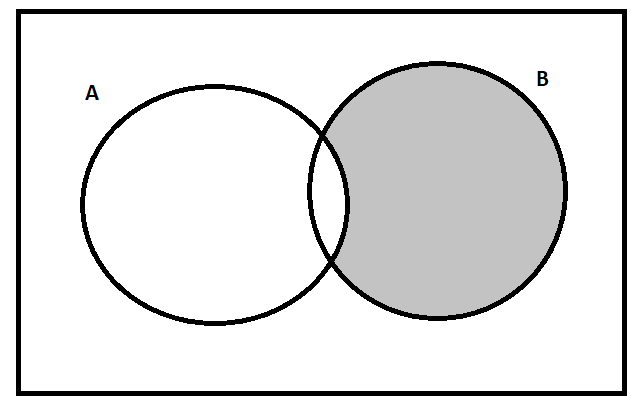
Let A = {3, 6, 12, 15, 18, 21}, B = {4, 8, 12, 16, 20}, C = {2, 4, 6, 8, 10, 12, 14, 16} and D = {5, 10, 15, 20}. Find B – A.
Answer
524.7k+ views
Hint: In set theory, the subtraction of a set A from a set B is given by the set obtained by removing all the elements of the set A from the set B. Using this concept, we can solve this question.
Complete step-by-step answer:
Before proceeding with the question, we must know the concept that will be required to solve this question.
Let us assume that we are given two sets A and B. In the set theory, the subtraction of the A from the set B which is denoted by B – A is given by the set obtained by removing all the elements of set A from the set B.

The shaded part in the above venn diagram represents the set B – A.
In this question, we are given set A = {3, 6, 12, 15, 18, 21} and set B = {4, 8, 12, 16, 20}. We are required to find B – A.
We can clearly observe that in set B, the only element which is also present in set A is 12. So, B – A is given by the set obtained after removing the element 12 from the set B.
Hence, the answer is the set {4, 8, 16, 20}.
Note: There is a possibility that one may remove the elements of set B from the set A instead of removing the elements of set A from the set B to find B – A which will give us an incorrect answer.
Complete step-by-step answer:
Before proceeding with the question, we must know the concept that will be required to solve this question.
Let us assume that we are given two sets A and B. In the set theory, the subtraction of the A from the set B which is denoted by B – A is given by the set obtained by removing all the elements of set A from the set B.

The shaded part in the above venn diagram represents the set B – A.
In this question, we are given set A = {3, 6, 12, 15, 18, 21} and set B = {4, 8, 12, 16, 20}. We are required to find B – A.
We can clearly observe that in set B, the only element which is also present in set A is 12. So, B – A is given by the set obtained after removing the element 12 from the set B.
Hence, the answer is the set {4, 8, 16, 20}.
Note: There is a possibility that one may remove the elements of set B from the set A instead of removing the elements of set A from the set B to find B – A which will give us an incorrect answer.
Recently Updated Pages
Master Class 10 Computer Science: Engaging Questions & Answers for Success

Master Class 10 Maths: Engaging Questions & Answers for Success

Master Class 10 English: Engaging Questions & Answers for Success

Master Class 10 General Knowledge: Engaging Questions & Answers for Success

Master Class 10 Science: Engaging Questions & Answers for Success

Master Class 10 Social Science: Engaging Questions & Answers for Success

Trending doubts
Is Cellular respiration an Oxidation or Reduction class 11 chemistry CBSE

In electron dot structure the valence shell electrons class 11 chemistry CBSE

What is the Pitti Island famous for ABird Sanctuary class 11 social science CBSE

State the laws of reflection of light

One Metric ton is equal to kg A 10000 B 1000 C 100 class 11 physics CBSE

1 ton equals to A 100 kg B 1000 kg C 10 kg D 10000 class 11 physics CBSE




